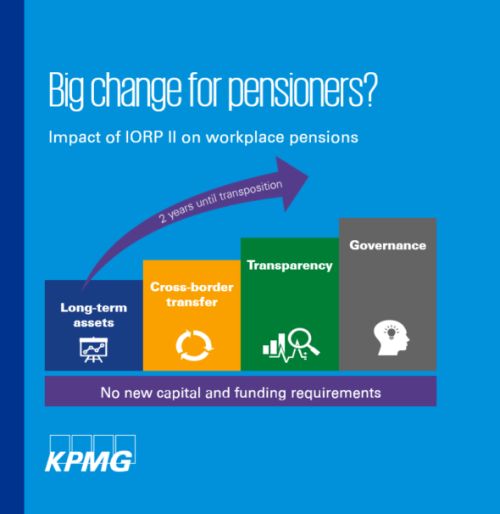The Institutions for Occupational Retirement Provisions (IORPs) have evolved since the publication, in 2003, of Directive 2003/41/EC on their activities and supervision (the "IORP Directive"). Aiming to align the IORPs framework with the pensioners and investors' current needs, a final compromise was reached between the Council of the European Union and the European Parliament to review the text. Directive 2016/2341 on IORPS (IORP II) was published in the Official Journal of the European Union on 23 December 2016, and Member States must transpose it by 13 January 2019.
Main goals of IORP II
The minimum harmonisation foreseen under IORP II Directive is intended to:
- enhance proper governance and transparency, establishing information obligations in relation to pensioners and publicly disclosed corporate documents and policies
- develop the regulatory framework on the conditions of operation of the IORPs, in the Member States and at European Union level
- set up the regime on IORP II for the cross-border transfers

How does IORP II affect you?
The conditions governing activities: IORPs shall have in place an effective system of governance, complying with the requirements for a fit and proper management and the regime for the persons carrying out key functions. The IORP II Directive also imposes obligations in terms of remuneration and self-assessed risk management systems.1
Transparency: The IORP II Directive foresees the publication of the Pension Benefit Statement, a standardised document to be sent to pensioners annually, providing simple and clear information about their pension entitlements. Documents concerning governance and the remuneration policy shall also be disclosed.
IORPs cross-border transfers: new procedures are in place to transfer IORPs and strengthen the cooperation between the supervision authorities of the Member States. In the event of cross-border activity, the technical provisions shall always be fully funded at all times for the total range of pension schemes operated.
Investment rules: Investment rules have been modernised in order to allow investments to foster the EU growth, considering as well responsible investments (environmental effects, for example).
Capital requirements will not change and solvency rules are kept from IORP I.
What are the next steps?
Member States have now two years to transpose this Directive into national law. Stricter rules may be imposed by national legislators, although there are no implementing or regulatory technical standards foreseen for the IORP II at the European level. This absence of complementary regulation reinforces the minimal harmonisation approach aimed at by the European Union in relation to IORPs.
What should you do?
- Assess any gaps in the risk management and governance systems, and perform a risk evaluation of the internal policies at least every three years or without delay following any significant change in the risk profile of the IORP.
- Check the compliance of the remuneration policy (and amend if necessary) and adapt the information provided to IORP pensioners.
- Bear in mind that IORPs can outsource their investment management from other Member States providers, which may have an impact on your servicing policies.
- Consider that the relevant supervisors hold the power to impose administrative penalties, and to carry out on-site inspections, stress-testing and specific supervisory review processes.
Footnotes
1. Zoom in on governance
This new governance framework requires the managers and persons in charge of the key functions to have the appropriate qualifications, knowledge and experience. These persons (and also IORP service providers) are also subject to a sound remuneration policy, which normally must be disclosed, and which is in line with the interest of pensioners, the risk profile and the objectives of the IORP.
Key functions (risk management, internal audit, compliance and actuarial if applicable) shall have their own written policies, which shall be reviewed each three years and approved by the management body. A single person or organisational unit may be allowed to perform one or more key functions, except for the internal audit function, which shall be independent.
A self-risk-assessment shall be carried out every three years minimum and to this effect the IORP II Directive foresees, as does IORP, the following documents:
- self-risk-assessment
- annual accounts and annual reports
- statement of the investment policy principles
The content of this article is intended to provide a general guide to the subject matter. Specialist advice should be sought about your specific circumstances.

